To face high-intensity, what tactical commander for tomorrow? Extracts of synthesis
On 6th February 2020 the Army organised a conference on military thinking, the theme of which was : “ To face high-intensity, what tactical commander for tomorrow ? ” This conference was preceded by a seminar aimed at introducing young people and students interested in defense issues to the operational realities of military life.
| Download extracts from the synthesis |
| See poster |
| Download the program |
| Watch the teaser |
 There is no definitive answer to the question of what a tactical leader should look like in the face of high intensity conflict. We must first define “high intensity”, which in my opinion is characterised by a phenomenon of physical, logistical and cognitive saturation, in both the tangible and intangible fields. Among commanding officers, “high intensity” evokes the battles we prepared for in the 1970s and 1980s, while for younger generations the point of reference remains external operations such as Barkhane. Both perspectives, however, are based on the unique nature of military action.
There is no definitive answer to the question of what a tactical leader should look like in the face of high intensity conflict. We must first define “high intensity”, which in my opinion is characterised by a phenomenon of physical, logistical and cognitive saturation, in both the tangible and intangible fields. Among commanding officers, “high intensity” evokes the battles we prepared for in the 1970s and 1980s, while for younger generations the point of reference remains external operations such as Barkhane. Both perspectives, however, are based on the unique nature of military action.
We must also have a fairly broad understanding of the concept of tactics, which can be applied at any level from the platoon to the division, or even up to the corps as a whole, although it will look different at each of these levels. The platoon leader’s fight is not the same as the fight experienced by a brigade or corps commander. What they have in common is uncertainty. Neither the section leader approaching an attack nor the operational leader knows whether they will have air superiority, weapons superiority or superiority in terms of influence.
Reflecting on the concept of high intensity is essential, given the state of the world, as discussed at the various round tables. The aim is therefore to be ready, to have soldiers and especially leaders who are up to facing the challenges of the future. What is at stake is the effectiveness of military action, the lives of the soldiers who will be involved in our future conflicts, and the safety of our country, its interests and, above all, our citizens.
The debates will revolve around 2 round tables:
Round table n°1
Is high-intensity warfare a sole high-technology warfare?
Hyper technology is undoubtedly at the heart of high-intensity warfare with swifter decision-making process and destruction being even more efficient, precise and controlled. After the asymmetrical conflicts of the last decades, the on-going technological levelling is the forerunner of symmetrical warfare and considerable human and material attrition. In this context, can the battlefield become chaotic in the very first contacts? Can the commander still see through it all?
Round table n°2
Rupture or continuity, can the commander of today be the commander of tomorrow?
With or without cutting-edge technology, the military commander of tomorrow remains a leader at the heart of the high-intensity warfare. Resilient and battlehardened, he must keep his clairvoyance and be the beacon of light for his soldiers. Will the commander be ready for tomorrow’s challenges? Do we need an “augmented commander” or to increase the ability for operating in downgraded environment?









